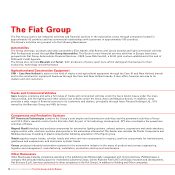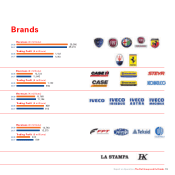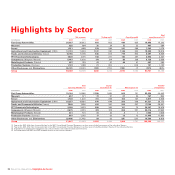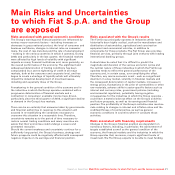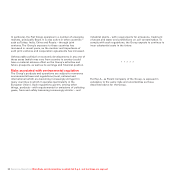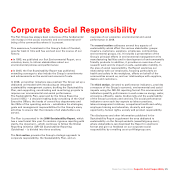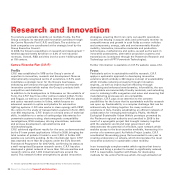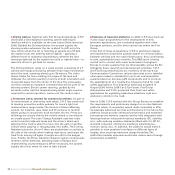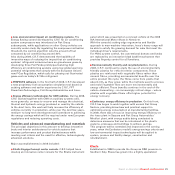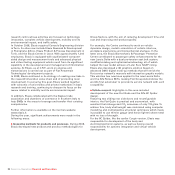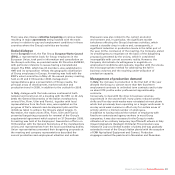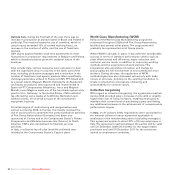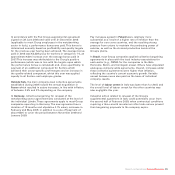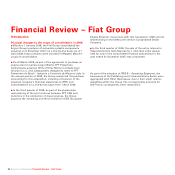Chrysler 2008 Annual Report Download - page 28
Download and view the complete annual report
Please find page 28 of the 2008 Chrysler annual report below. You can navigate through the pages in the report by either clicking on the pages listed below, or by using the keyword search tool below to find specific information within the annual report.Report on Operations Research and Innovation 27
advanced virtual simulation techniques, can reproduce the entire
design and production process, reducing cost and time and
increasing the opportunity for inter-Sector synergies.
C.R.F.’s activities are focused in the following areas.
Powertrain Research and Technology
Here, the principal objective is to develop and apply innovative
technologies which improve powerplant performance, cutting
engine and vehicle emissions, and boosting fuel economy.
C.R.F.’s most significant achievements in this area during 2008
are as follows:
Multijet II. In 2008, C.R.F. completed development work,
functional validation and reliability testing on the Multijet II
system applied to the Euro 5-compliant 1.3-litre SDE Small
Diesel Engine, demonstrating the new solenoid injector’s
potential in cutting fuel consumption and emissions. The
Multijet II system is scheduled to enter production in 2009 on
the 95 hp Euro 5 1.3-litre SDE Lancia Musa, and will later be
installed on all Euro 5-compliant applications with 75 and 95
horsepower 1.3-litre SDE engines. In addition, the Centre
launched a study of the technology’s potential on heavy
commercial vehicle engines, installing the Multijet II servovalve
developed for passenger car applications on initial prototype
injectors which were then bench-tested on the Cursor 9 truck
engine.
Multiair. The Multiair technology will go into production
during 2009 on the 1.4-litre 16-valve FIRE gasoline engine and
the new 900 cc two-cylinder SI engine in the Small Gasoline
Engine (SGE) family. The technology was applied to the
cylinder head of the 2.0-litre B Family diesel engine to test the
potential of the system’s fast, flexible and precise air metering
and internal EGR exhaust gas recirculation. An Alfa 159 demo
vehicle showed that the system produces significant benefits
for oxides of nitrogen emissions. Further benefits include
higher low-end torque, smoother cold weather operation, more
even torque delivery, and no engine shake at shut-off. The
additional cost of installing the system on a diesel engine is
largely offset by the fact that all external HP-EGR high-pressure
exhaust gas recirculation components and the throttle valve
can be eliminated, while a lower noble metal content is
required in the catalytic converter.
Cursor CNG Multiair engine. In recent years, the performance
of heavy compressed natural gas engines has advanced to the
point where it is comparable, if not indistinguishable, from that
of their diesel counterparts, as a result of structural
improvements in cylinder head design. In 2008, moreover, CNG
engines featuring spark ignition stoichiometric combustion
technology together with 3-way catalytic exhaust gas
aftertreatment were shown to meet all Euro 6 emissions limits,
a full five years in advance of these regulations coming into
effect in Europe. In 2008, the Multiair technology was applied
to the 6-cylinder 7.8-litre HD CNG Cursor engine to test its
potential in cutting CO2emissions. The results demonstrated
that the same levels of performance as the equivalent diesel
version can be achieved with even lower CO2output and
consumption than the Cursor CNG engine currently in
production.
Hybrid city car propulsion system. During 2008, development
began on a hybrid propulsion system tailored to city cars. This
hybrid drive setup consists of the 900 cc two-cylinder SI engine
from the SGE family, combined with an innovative DDCT Dual
Dry Clutch Transmission featuring an electric motor coupled to
one of its two mainshafts. The SGE engine’s small size makes it
possible to use a simple, efficient transmission architecture,
while coupling the motor downstream of the clutches means
that all the characteristic functions of a parallel hybrid
propulsion system, including electric drive, regenerative
braking and torque boost from the two motors, can be
provided in a compact, lightweight package: essential for small
urban runabouts. The hybrid propulsion system uses air-cooled
lithium ion batteries housed in the car’s trunk. Other features
include plug-in traction battery recharging and an HVAC system
that can be powered by either the IC engine or the electric
motor, using whichever unit provides peak efficiency at any
given time.
Advanced Technology for Mobility and Safety
The principle objective of this activity is to guarantee the Fiat
Group has the technical know-how in secondary systems,
electronics, telematics and preventive safety needed to
improve mobility by making vehicles safer, more versatile and
more eco-compatible. Major achievements in 2008 included:



